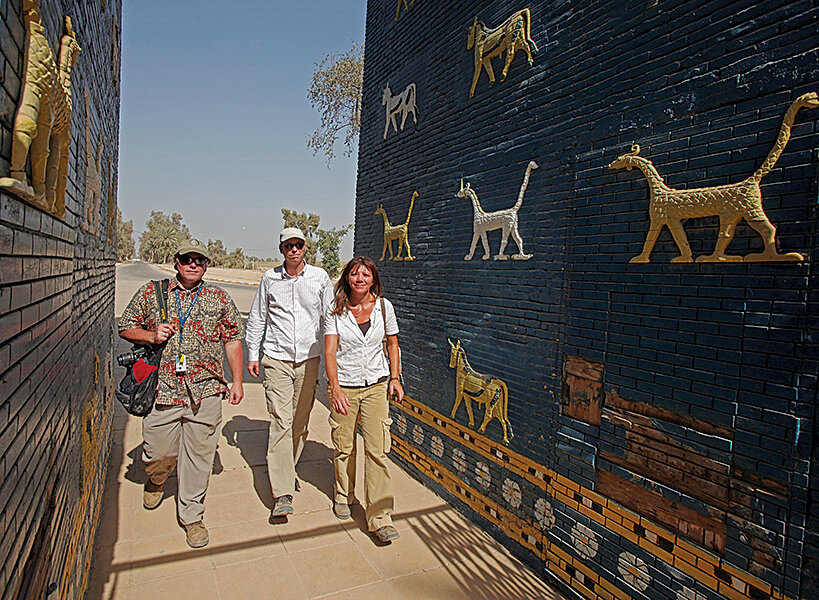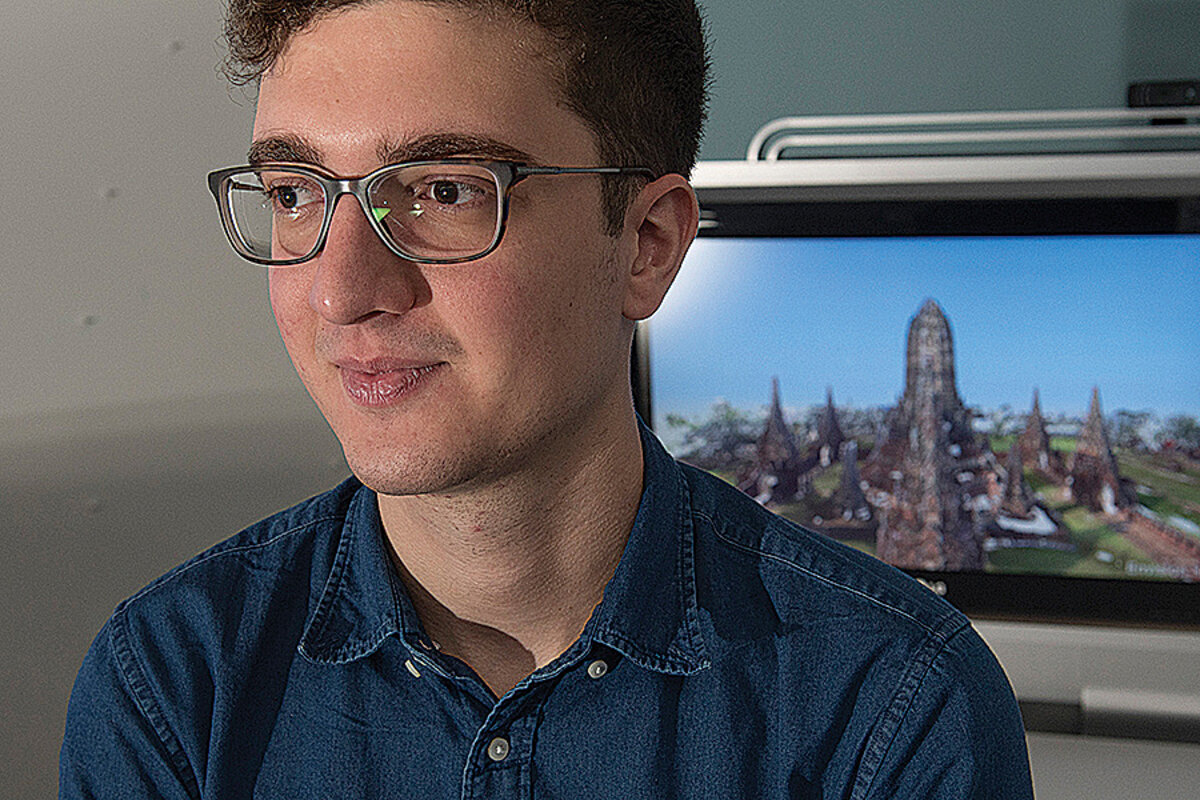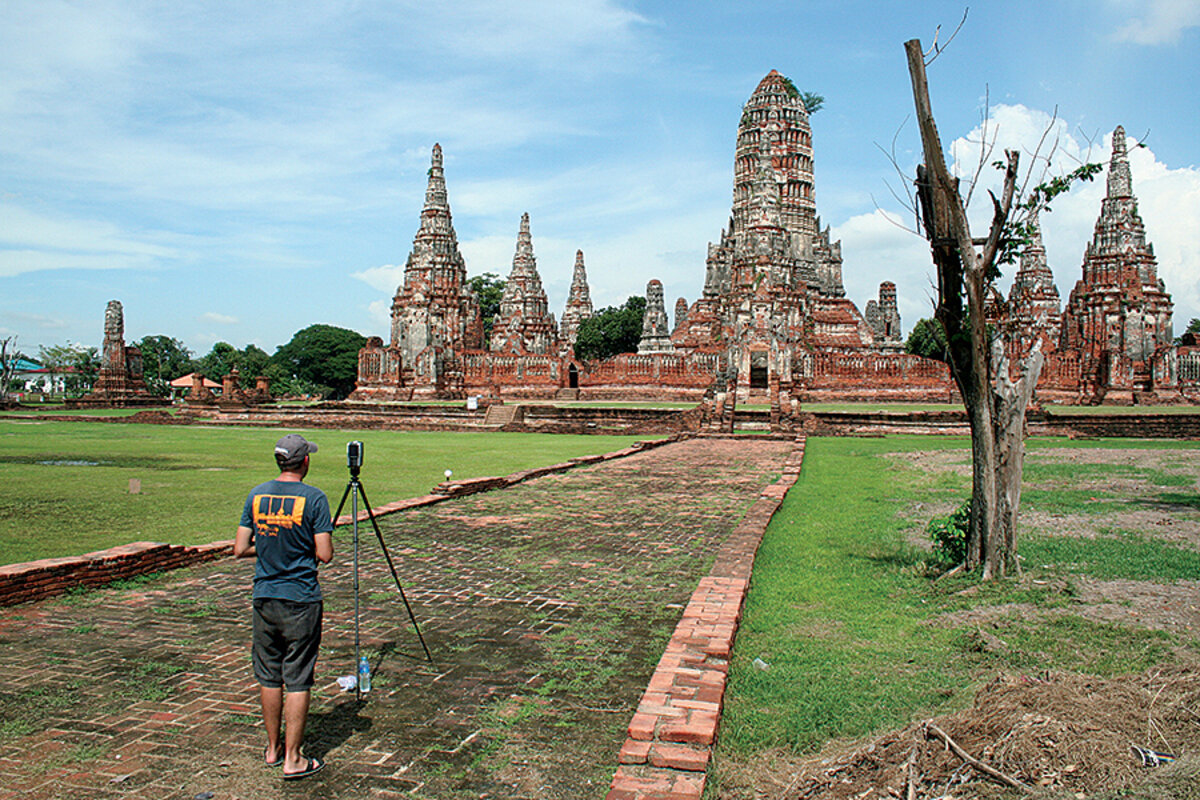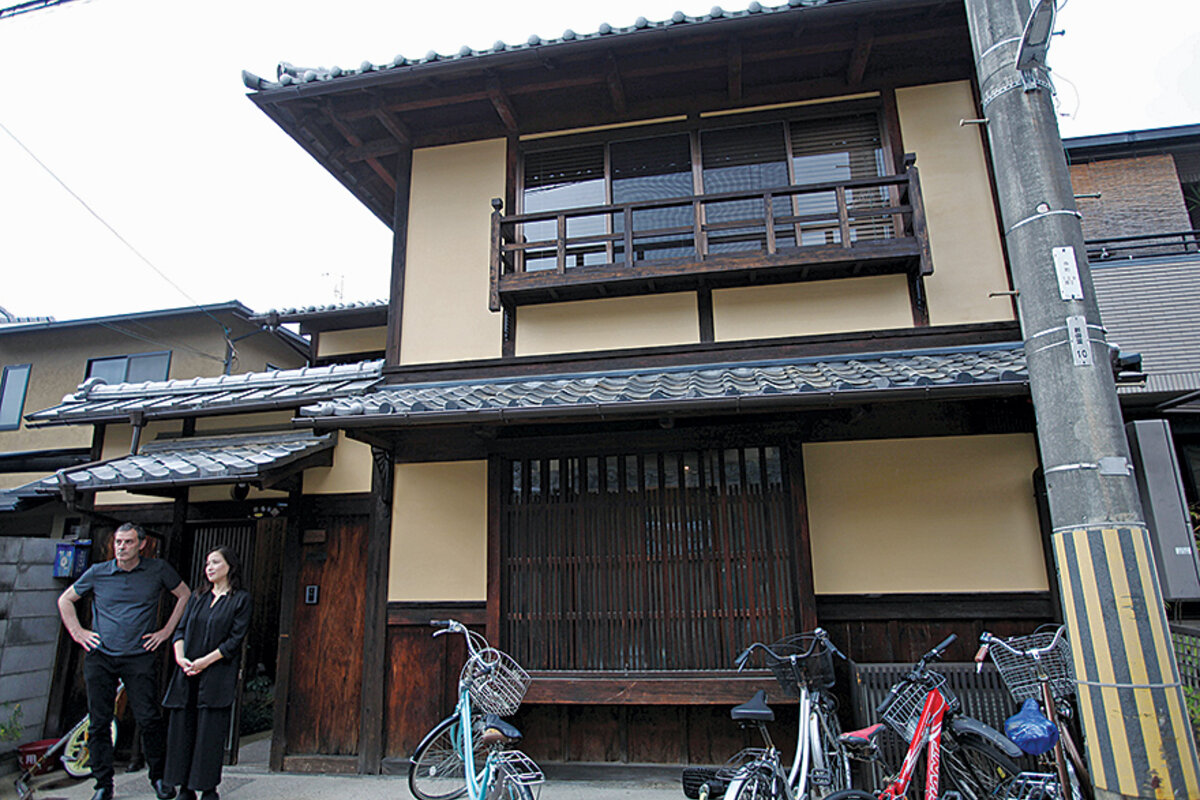The preservation warriors: saving the past for the future
Loading...
| New York
Daniel Kruel is used to wandering through ancient Babylon. He strolls down the city’s buff-colored streets. He glides past the imposing Ishtar Gate, built by King Nebuchadnezzar II around 575 BC. He meanders down an avenue flanked by high brick walls toward a distant staircase, and stops to admire the outlines of a willowy creature with a dragon’s head.
The unusual sculpture is one small reminder that Babylon was once a seat of architecture, culture, and learning – as the Greek historian Herodotus put it, “in magnificence there is no other city that approaches it” – even though it would also earn a reputation for sin and godlessness with its Tower of Babel.
Mr. Kruel experiences all this musty history without leaving his office in Florida.
A graduate student in urban planning at the University of Florida in Gainesville, Kruel is occupying a virtual Babylon using a technology that is rapidly becoming a tool for organizations such as the New York-based World Monuments Fund, a nonprofit dedicated to the conservation of cultural heritage. Founded 50 years ago by Army Col. James Gray, the WMF has been involved in preserving more than 600 sites in 90 countries. Beholden to no government and hampered only by the amount of money it can raise, the WMF offers a window into the challenges involved in preserving buildings, archaeological sites, and artworks – and why the world collectively spends billions of dollars each year to do this.
The need for such work today is more urgent than ever. Since humans first painted on cave walls and chipped stone into objects, they have seen their handiwork succumb to floods, earthquakes, and, in recent centuries, the incessant march of industrialization and modernity. Today, additional destructive elements are also rasping away at the past – from terrorists to global warming. In the first 10 years of this century, UNESCO added 17 cultural sites to its List of World Heritage in Danger. In the past six years, that number jumped to 27 and, for the past decade, the WMF has been so alarmed at the devastation wreaked by war and natural disasters that it has begun including entire countries, such as Iraq and Nepal, on its biennial watchlist of sites.
Experts agree that, as Randall Mason of the University of Pennsylvania puts it, preservation is “not just a kind of artistic interest of rich people.” All of us are preservationists, he says. We pass down family Bibles, an ancestor’s pocket watch, the letter a great-grandmother received from the old country. Social groups, too, have what scholars call a collective memory that is associated with their physical surroundings. The legacy of monuments, buildings, and old town squares informs our very identities.
The WMF’s project in Babylon epitomizes what preservationists are trying to do to prevent the loss of significant sites. Foreseeing a day when tourists would return to Iraq after years of war, the WMF partnered with the Iraqi State Board of Antiquities and Heritage and sent a team from the California-based CyArk to map the site. Using a scanner system developed by CyArk’s founder, the team took just days to amass millions of measurements accurate to less than one-sixth of an inch. In Kruel’s computer they coalesce into a “point cloud,” a 3-D model so precise that it can often enable specialists to spot problems more easily than when physically on site.
Today, Kruel finds it sadly ironic that a project intended to help ensure a site’s longevity could become the most complete record of its past existence. To date, fighters with Islamic State have damaged all six of Syria’s UNESCO-designated World Heritage sites, including the televised destruction of 2,000-year-old Palmyra. By September of last year, it had blasted, bulldozed, and smashed ruins, statuary, and artifacts in Iraq – among them, parts of the 2,800-year-old Nabu temple.
“What hurts is that erasure of history and memory,” says Lisa Ackerman, the WMF’s executive vice president and chief operating officer. “No place is more important than people, but at the same time, people and places are intertwined.”
At an Asia Society forum in New York last year, the director-general of UNESCO, Irina Bokova, coined the phrase “cultural cleansing,” charging that “an attack against culture is an attack against people, their identity, and their human rights.” Speculating as to why the terrorists destroyed Palmyra, Nasser Judeh, Jordan’s deputy prime minister and minister of foreign and expatriate affairs, noted that the city had been a vibrant, multicultural society. “History delegitimizes terrorists,” he said. “Therefore to claim more legitimacy, they need to destroy history.”
Rewriting the past is, sadly, nothing new. Rome sacked Jerusalem. Nazis blasted enemies’ cultural landmarks. Saddam Hussein razed parts of Babylon to build a palace with bricks stamped “This was built by Saddam, son of Nebuchadnezzar, to glorify Iraq.” “Since time began, we’ve been destroying things and restoring them,” says Ms. Ackerman.
What is new, she says, and the reason people react with such horror, is that images travel fast. Whether it is the Taliban pulverizing the Bamiyan Buddhas in Afghanistan or militants setting fire to books in Mosul, Iraq, “It feels immediate because we find out instantaneously.”
Something else has also changed over time: attitudes. Responding to the upheaval of industrialization and modernity, prominent citizens in the 19th century joined artists and intellectuals to spearhead a movement that later gave rise to legislation, guidelines, and conventions the world now takes for granted. This year marks the 50th anniversary of the US National Historic Preservation Act, and next year it will have been 25 years since UNESCO ratified the Convention Concerning the Protection of the World’s Cultural and Natural Heritage.
“Individually or collectively as a group, as a community, we need [preservation] – psychologically, sociologically – to be able to manage all of the changes that we’re asked to [cope with] on a daily basis,” says Morris Hylton III, who directs the University of Florida’s Envision Heritage program.
Students of preservation such as Kruel quickly learn that terrorism is just one among countless threats. Shifts in temperature and water levels due to climate change destabilize artworks and structures. Fire, floods, erosion, volcanic eruptions wipe out entire towns. Air reduces metals to rust. Moisture weakens foundations. And light, over time, bleaches murals and paintings.
People, too, pose a threat. With every war, humans wreak devastation. As tastes and needs change, societies tear down the old to make way for the new. Even efforts to salvage cultural treasures sometimes backfire. Cement, once a popular panacea, over time leached corroding salts into the structures it was intended to preserve. Finally, there is simply not enough room to keep all the objects man builds, carves, paints, sculpts, designs.
So the issue is not whether humans can save everything – they can’t – but choosing what to save. “That’s part of the interesting risk in historic preservation,” says Mr. Mason, Penn’s chair of historic preservation, because “we’re trying to understand what society is going to need in the future in the way of an archive of sites and places and stories. And we’re willing to bet our reputation and spend our treasure now on what we think is going to be useful in the future.” The significance of a building or site does not rest solely on its particular architectural features, age, or size. “It’s the story attached to a place” that people value, he says.
Yet narratives are fluid. The ancient city of Palmyra is a case in point. European travelers who stumbled on it in the 18th and 19th centuries so prized its aesthetics that its columned ruins triggered a revival of neoclassical architecture and urban design. Today, when cultural friction seems to cause more death than dialogue, many value Palmyra’s mixture of Greco-Roman, Persian, and local styles for a different reason – as proof that multicultural societies can thrive.
“The ancient city’s prosperity arose thanks to its citizens’ ability to trade with everyone, to integrate new populations, to take on board diverse cultural influences, to worship many gods without conflict,” classicist Tim Whitmarsh eulogized in The Guardian. He hailed it as “antiquity’s icon of cultural diversity.”
Built by a succession of Khmer rulers from the 9th through 14th centuries, the stone temples at Angkor in northwestern Cambodia sport towers in the form of lotus buds. Reliefs teem with dancing figures and meditating Buddhas, and causeways are lined with the carvings of multiheaded snakes. Last year alone, 2 million visitors walked among the ruins.
The site illustrates a lesson Mason impresses on his students: It is possible to retain the cultural significance of a place while allowing “a pretty significant amount of change.”
The challenge that places such as Angkor pose is that, over the centuries, they have meant different things to different people. Westerners, for example, mostly learned of Angkor from 19th-
century French artists and art historians. They followed Cambodian guides into jungle thickets where tree roots snaked between stone blocks, sometimes forming nets that held carvings in place. Giant faces peered through the foliage, and ornate doorways led into labyrinths of chambers and halls. It was, as one French writer described it, “another kind of beautiful.” Then, as now, Angkor fires Westerners’ imagination with its promise of mystery and discovery.
In Southeast Asia, on the other hand, people look to Angkor as part of their heritage. It influenced temple architecture for centuries, and for locals the ruins of Angkor retain a sacredness.
At some level, says Ranachith Yimsut, “Angkor is just stone, but people give it value – like a diamond.” Born in 1961, Mr. Yimsut grew up near Angkor and was the only member of his immediate family to survive the Khmer Rouge killing fields. After a harrowing escape into Thailand, he immigrated to the United States in 1978, eventually becoming a landscape architect for the US Forest Service.
When Yimsut was a child, the national anthem he sang at school spoke of temples “asleep in the forest.” Mostly he remembers the temples as his playground, a perfect setting for mock sword fights. By the time he turned 13, however, the fighting around him was real. “For three months,” he says, “Angkor had no other value but as a shelter.” Forced out of their village by Khmer Rouge soldiers, he and his family slept on its stones and foraged its jungle for food.
When he traveled back to Cambodia at age 30, those same structures now struck him as marvels of design. The WMF was already active on the site after the ouster of the Khmer Rouge. Most Cambodians trained in archaeology had been killed, and for the next dozen years, Yimsut intermittently consulted with the WMF, which recruited surviving tradesmen and trained a new generation. This was important to Yimsut, who today believes Angkor’s stones need to be preserved as a cultural and spiritual touchstone as well as a source of income – “as bait for tourists,” he says.
He is not alone. In many parts of the 1,000-acre Angkor Archaeological Park, the sound of chipping, sanding, scraping, and digging mingles with the scurry of lizards, the voices of tour guides, and myriad bird calls. For almost 30 years, governments, foundations, corporations, and individuals have invested more than $60 million to save Angkor’s structures and artwork as a tourist destination.
This includes $9.25 million from the WMF, whose teams always begin with meticulous research. At the turn of the 10th century, for instance, Khmer builders had cut into a hill and used its bedrock as the foundation for the monumental Phnom Bakheng temple. “But nature,” says Cheam Phally, WMF’s senior architect at Angkor, “cannot make a square,” so the corners were weak and, with time, collapsed. As the building settled and the jungle crept in, the temple’s five levels shifted, making the structure unstable.
Starting in 2007, a WMF team shored up the foundation and waterproofed it with plastic membranes. To the extent possible, conservators make sure anything they do can be undone. Here, they pinned the laterite and sandstone blocks to the bedrock, surveyed every stone looking for deterioration, and, most important, determined the angle of its slope. The team had previously discovered that Khmer builders set the stones at a 3 percent slope, which allowed water to drain off. So that’s how they reset them.
Now that the structure is sound, says Mrs. Cheam Phally, the challenge is managing the crush of tourists. To prevent overcrowding, the WMF and APSARA Authority, which oversees the site, decided to limit the daily number of Bakheng visitors to 300. This caused some grumbling, says Cheam Phally, “and we don’t want tourists to be unhappy. Therefore we set up a wooden platform where more can view the sunset.”
Even as he champions tourism, Yimsut worries that “too much commercialization can dilute Angkor’s spiritual essence.” After several visitors posed in various stages of undress last year, the APSARA Authority has imposed new restrictions on photography and a dress code. Yimsut hopes such measures will allow Cambodians to preserve both Angkor’s stones and its spirituality.
“Without Angkor,” he says, “we’d have to reinvent ourselves.”
Until the 1960s, choosing what to preserve was the domain of experts – historians, scholars of art and architecture, museum curators, classicists, and the like. The spirit of the civil rights movement changed that by giving a greater voice to grass-roots leaders and organizations. The WMF’s World Monuments Watch reflects this. Launched in 1995, it is a list of sites that need help, selected from nominations professionals and laymen alike now submit. Every cycle, the Watch receives some 200 to 300 recommendations.
The WMF approach reflects a marked change from the earliest days of historical preservation, when colonial powers dictated what to save and how. One way it avoids the colonial trap is by working in tandem with local partners.
In 2008, for example, two groups in Japan, the Kyomachiya Council and the Kyoto Center for Community Collaboration, nominated traditional townhouses called machiya for the WMF’s Watch. Nicknamed “eel residences,” machiya are long, narrow townhouses originally built by the growing merchant class during Japan’s Edo period (1603-1867). The room facing the street served as the shop, while the owner’s family lived behind it in a suite of rooms interrupted by a small garden. Made mostly of wood, bamboo, mud, and paper, machiya were not built to last centuries.
Between 2008 and 2010, some 600 volunteers took to the streets of greater metropolitan Kyoto and counted just under 48,000 machiya – many deteriorating. The survey also showed that more than 700 machiya – 1.6 percent of the total – were disappearing each year.
Unlike castles built by shoguns or temple complexes funded by wealthy samurai, machiya don’t figure in old records. “With scarce references,” Riyako Tsuyuki of the Kyomachiya Council writes in an email exchange, “you can never regain the original [once lost].”
This means that the structures themselves are the only surviving record of this efficient, sustainable, and human-scale home design. The buildings also incorporate traditional techniques used by carpenters, plasterers, gardeners, and other skilled tradesmen. In 1999, some 30 such craftsmen formed Sakuji-gumi, a group that for the past 10 years has partnered with the Kyomachiya Council.
After the WMF included machiya on its watchlist, first in 2010 and again in 2012, it worked with these local organizations to educate the public, train craftsmen, and fund the restoration of three machiya. One now serves as a resource center for machiya owners.
Over the past 20 years, the World Monuments Watch has called attention to 790 sites in more than 135 countries and territories. Many were already famous – the Taj Mahal in India, New York’s Ellis Island, the canaled city of Venice. Others not so much: a late 19th-century Russian Orthodox Church in Alaska, Cyprus’s historic city of Famagusta, Zimbabwe’s Nalatale ruins. Regardless of prior fame, many listed have attracted funders. Over the Watch’s 20-year history, the WMF itself has invested $100 million in various sites, while other groups or individuals have stepped forward with more than $245 million.
• • •
Newspapers could any day report that terrorists have flattened another cultural treasure in the Middle East. Or an earthquake has brought down temples in Asia. Or flooding has wiped out historical buildings along US coasts.
Our descendants will, as we do, know about the past largely through salvaged fragments of buildings and cities, written records, documents, and images. But, as Mr. Hylton and Kruel of Envision Heritage demonstrate, they will potentially also have virtual models so accurate one might wonder whether they could substitute for the real thing.
“Nothing replaces being on a site,” says Hylton. But as he sits with his graduate student, eyes on the monitor, he is astonished. “I never believed in my lifetime,” he says, “that I would be able to understand a site, rather intimately, and even diagnose the conditions on the site without ever having gone there” except virtually.
Sometimes, Kruel says, being there physically even has disadvantages. “There’s people walking around, it’s distracting, you can’t really focus...,” he says. “Having the point cloud, you can go back at a later time when you’re comfortable and you can take your time looking around.” Turning on a computer, though, can’t compare to traveling to a distant place, experiencing the smells, tastes, climate, people. So while having a virtual replica may mitigate the sense of loss should the original disappear, it is no substitute.
Not yet, at least. Add goggles and host the point cloud on a server like those used for video games, and Kruel can imagine a time when he might visit the Ishtar Gate virtually, meet someone else roaming there remotely, and have the kinds of experiences that imbue objects with stories, memories, and ultimately meaning.
Even if this never comes to pass, these virtual replicas are so valuable that they are now one more thing we need to safeguard. “We know how long drawings made of a certain ink on a certain paper are going to last,” says Hylton. “We don’t know how long these digital files will last.”
But task forces are at work saving them because, as Hylton and other preservationists believe, we are healthier individually and collectively when we retain connections to the past – virtually and physically.











